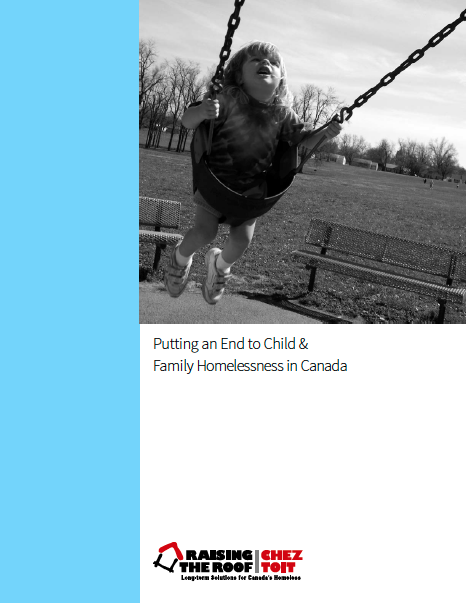The State of Homelessness in Canada 2014 says that for every person who is unsheltered, there are at least three people experiencing hidden homelessness. Applied nationally, this conservative estimate of 3:1 means at least 50,000 Canadians are homeless on any given night. Women including, mothers and their children, are much more likely to be among the hidden homeless population. YWCA Canada’s When There’s No Place Like Home states that families experiencing homelessness are largely led by single mothers. Some families choose not to access shelter services because they don’t feel that shelters are safe. They may instead be temporarily stay with extended family and/or friends so as not to displace their children from their school/community.
A recent study by Raising the Roof highlights some of the causes of family homelessness, including family violence, a lack of affordable housing, low wages, un/underemployment, and low rates of social assistance. The study underlines that child and youth homelessness often leads to chronic adult homelessness, criminality, experiences with the child welfare system, and worsening mental health. Childhood stressors and trauma such as family breakdown, poverty, conflict, and abuse are not only contributing factors to child and youth homelessness but also childhood homelessness itself has been linked as a pathway to adult homelessness.
According to the State of Homelessness in Canada 2014, there are a number of signs that a family may be at risk of homelessness, including:
- Unaffordable rental housing units.
- Falling below the Market Basket Measure (MBM) poverty threshold and/or living below the Low Income Cut-off (LICO).
- Experiencing moderate or severe food insecurity.
- Stagnant or declining wages during periods of sustained economic and employment growth.
As these warning signs indicate, for many parents, one illness, layoff, family crisis, or loss of childcare can put them and their children over the edge. Without a national housing and homelessness strategy or comprehensive provincial/territorial and federal action to address system failures while strengthening Canada’s safety net, the number of families at risk of homelessness will rise.
Moving Forward
Family homelessness disproportionately impacts some groups who experience greater levels of poverty than the general population, including Indigenous Peoples, racialized, newcomer families, parent(s) with a disability or single mothers. Service providers, researchers and policy-makers are beginning to recognize the distinct challenges of sub-populations and that providing supports and developing better policies will help create solutions to ending homelessness.
Putting an End to Child & Family Homelessness in Canada includes a number of policy recommendations for all levels of government as well as service providers that reflect the demands and advocacy efforts by those working in the housing, homelessness and anti-poverty groups. Discussions about funding priorities, sharing of resources, and new models of service provision that draw in all sectors must continue.
With so many solutions and recommendations discussed among stakeholders, what are we waiting for?
Photo credit: Raising the Roof, 2016


